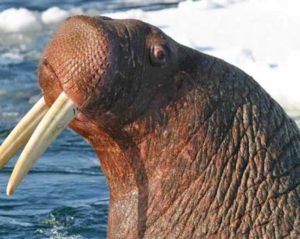
Alaska Native people have lived along the coasts of the Chukchi and Bering seas in northwest Alaska for thousands of years. The rich bounty of the ocean, including marine mammals, fish and birds, has sustained these communities, not only feeding them, but also shaping their traditions, culture, identity and health.
The Pacific walrus is an important subsistence resource for these Arctic communities. Its meat and blubber are prized as a food source, and its ivory tusks are used for practical and artistic purposes. Although Alaska Native hunters have adopted modern tools such as motor boats and GPS, they still look to traditional knowledge about weather, sea ice and walrus behavior to inform decisions about where and when to hunt. But dramatic changes have taken place in the Arctic. Warming temperatures and receding sea ice have affected the movements and distribution of walrus. Weather patterns are also changing, bringing more frequent storms and unpredictable conditions that make it more difficult to plan safe and successful hunts.
In an effort to assist Alaska Native communities and others interested in sea ice and walruses, ice scientists in partnership with the Eskimo Walrus Commission and several local village monitors developed a web-based resource called the Sea Ice for Walrus Outlook (SIWO). The SIWO provides weekly reports (Outlooks) during the spring sea ice season about weather, ice, marine mammals and other conditions relevant to walrus in the northern Bering Sea and southern Chukchi Sea regions of Alaska. The Outlooks combine information from the National Weather Service with data from sea ice observers in seven coastal communities: Wales, Shishmaref, Nome, Brevig Mission/Port Clarence, Gambell, Savoonga, and Diomede. Additional information, including annotated satellite imagery, written observations, and photographs is collected in the Outlook. Information is compiled and disseminated weekly by the Arctic Research Consortium of the US (ARCUS) from April through June.

Although the need for and interest in SIWO appears to be strong, University of Alaska Fairbanks research assistant professor Nathan Kettle wants to know if the Outlooks can better support subsistence hunters and coastal communities in the face of rapid change. Kettle, whose expertise is in climate adaptation, knowledge co-production, and evaluation, is leading a team of researchers from Alaska Sea Grant, the University of Alaska Fairbanks (UAF), the Eskimo Walrus Commission and ARCUS, to better understand who is using SIWO and how it could be improved. Alaska Sea Grant is funding the research as part of its mission to sustain resilient coastal communities and help them respond and adapt to environmental change.
“Our research is designed to understand how SIWO can better support communities, as well as how it might bring local and traditional knowledge together with Western science to support decision making,” Kettle explained. “We want to learn not only how best to disseminate the SIWO information and which stakeholder groups are using it, but also how it might facilitate better information exchange among different users and across communities.”
Amy Hendricks, a PhD student in the UAF Department of Atmospheric Sciences, is working with Dr. Kettle to evaluate SIWO and gather feedback from current and potential users. She is conducting interviews with coastal residents, sea-ice forecasters, and other experts to listen and understand how SIWO is being used. The feedback received from these findings will then be used to design surveys distributed to agencies, researchers and the National Weather Service. All of the feedback will be shared through forums and other communications.
Kettle explained that the research is an iterative process, gathering as much information from as many users as possible, then presenting findings and getting new feedback to inform the process. The project will engage a full scope of partners in the design and analysis of the project.
“This research highlights the value of community-informed science” said Hendricks. “We’re asking what are the needs of the communities as far as weather data and support, but also what insight can the communities provide to make that science better.”
The research team plans to implement a set of recommendations to improve sea ice and weather forecasts and communication in ways that help communities adapt to changing conditions. Anticipated outcomes include a better understanding of stakeholder needs, safer hunting and maritime travel among subsistence hunters, increased access to and use of National Weather Service forecasts, and advanced understanding of how local observations can support and improve National Weather Service monitoring and notification.
As climate change continues to impact subsistence harvesting in Alaska, it will be important for tools such as SIWO to provide value to the communities they serve. “Ultimately, this is really important co-produced science that addresses the critical issue of food security,” said Hendricks.
Source: Alaska Sea Grant
